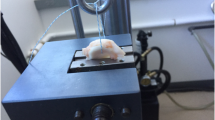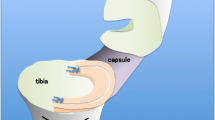Abstract
This in vitro biomechanical study with cyclic loading compared the pullout strength of vertical, horizontal, and oblique sutures used for meniscal lesion repair. Following repair of vertical longitudinal lesions created in bovine medial menisci, three groups of seven specimens (vertical, horizontal, and oblique sutures) underwent cyclic loading in a randomized test order (5 mm/min, cycling between 5 and 50 N at 1 Hz for 100 cycles) prior to load to failure testing (5 mm/min). Displacement did not differ between groups during cyclic or load to failure testing. Construct stiffness during cyclic testing was superior for the oblique suture (6.9 ± 1.5 N/mm, P = 0.007) and the vertical suture (6.4 ± 7 N/mm, P = 0.03) groups compared to the horizontal suture group (4.4 ± 0.52 N/mm). The oblique suture (171.9 ± 25.9 N, P < 0.0001) and the vertical suture (145.9 ± 32.3 N, P = 0.001) groups displayed superior load at failure compared to the horizontal suture group (88.8 ± 8.2 N). Construct stiffness during load to failure testing did not differ between groups. Suture rupture was the failure mode for all specimens of the oblique suture group. Suture rupture was the failure mode for 57% (4/7) of the vertical suture group with the remaining specimens (3/7, 43%) failing from intact suture pullout through meniscal tissue. All horizontal suture group specimens failed by intact suture pulling through meniscal tissue. With comparable stiffness during cyclic testing, comparable load at failure as vertical sutures, and less evidence of intact suture pullout through the meniscus, an oblique suture technique may combine the beneficial characteristics of vertical (superior biomechanical strength) and horizontal (ease of application, longer sutures with a tendency to cover a larger meniscal tissue area) suture-repair techniques.






Similar content being viewed by others
References
Asik M, Sener N (2002) Failure strength of repair devices versus meniscus suturing techniques. Knee Surg Sports Traumatol Arthrosc 10(1):25–29
Barber FA (1994) Accelerated rehabilitation for meniscus repairs. Arthroscopy 10(2):206–210
Barber FA, Stone RG (1985) Meniscal repair. An arthroscopic technique. J Bone Joint Surg Br 67(1):39–41
Boenisch UW, Faber KJ, Ciarelli M, et al. (1999) Pull-out strength and stiffness of meniscal repair using absorbable arrows or Ti-Cron vertical and horizontal loop sutures. Am J Sports Med 27(5):626–631
Borden P, Nyland J, Caborn DNM, Pienkowski D (2003) Biomechanical comparison of the FasT-Fix meniscal repair suture system with vertical mattress sutures and meniscus arrows. Am J Sports Med 31(3):374–378
Henning CE, Clark JR, Lynch MA, et al (1988) Arthroscopic meniscus repair with a posterior incision. Instr Course Lect 37:209–221
Hsieh HH, Walker PS (1976) Stabilizing mechanisms of the loaded and unloaded knee joint. J Bone Joint Surg Am 58(1):87–93
Karaoglu S, Duygulu F, Inan M, Baktir A (2002) Improving the biomechanical properties of the T-fix using oblique direction: in vitro study on bovine menisci. Knee Surg Sports Traumatol Arthrosc 10:198–201
Kohn D, Siebert W (1989) Meniscus suture techniques: a comparative biomechanical cadaver study. Arthroscopy 5(4):324–327
Kurosawa H, Fukubayashi T, Nakajima H (1980) Load-bearing mode of the knee joint: physical behavior of the knee joint with or without menisci. Clin Orthop 149:283–290
MacConaill MA (1950) The movements of bones and joints: the synovial fluid and its assistants. J Bone Joint Surg Br 32(2):244–252
Post WR, Akers SR, Kish V (1997) Load to failure of common meniscal repair techniques: effects of suture technique and suture material. Arthroscopy 13(6):731–736
Proctor CS, Schmidt MB, Whipple RR, et al (1989) Material properties of the normal medial bovine meniscus. J Orthop Res 7(6):771–782
Rankin CC, Lintner DM, Noble PC, et al (2002) A biomechanical analysis of meniscal repair techniques. Am J Sports Med 30(4):492–497
Rimmer MG, Nawana NS, Keene GC, Pearcy MJ (1995) Failure strengths of different meniscal suturing techniques. Arthroscopy 11(2):146–150
Sgaglione NA, Steadman JR, Shaffer B, et al (2003) Current concepts in meniscus surgery: resection to replacement. Arthroscopy 19(Suppl 1):161–188
Song EK, Lee KB (1999) Biomechanical test comparing the load to failure of the biodegradable meniscus arrow versus meniscal suture. Arthroscopy 15(7):726–732
Sweigart MA, Zhu CF, Burt DM, DeHoll PD, Agrawal CM, Clanton TO, Athanasiou KA (2004) Intraspecies and interspecies comparison of the compressive properties of the medial meniscus. Ann Biomed Eng 32(11):1569–1579
Voloshin AS, Wosk J (1983) Shock absorption of meniscectomized and painful knees: a comparative in vivo study. J Biomed Eng 5(2):157–161
Author information
Authors and Affiliations
Corresponding author
Rights and permissions
About this article
Cite this article
Kocabey, Y., Taser, O., Nyland, J. et al. Pullout strength of meniscal repair after cyclic loading: comparison of vertical, horizontal, and oblique suture techniques. Knee Surg Sports Traumatol Arthrosc 14, 998–1003 (2006). https://doi.org/10.1007/s00167-006-0079-9
Received:
Accepted:
Published:
Issue Date:
DOI: https://doi.org/10.1007/s00167-006-0079-9




